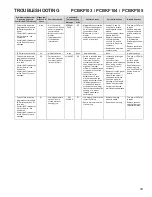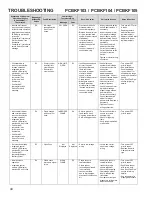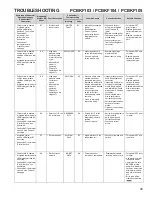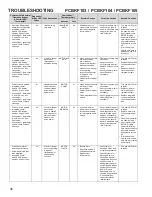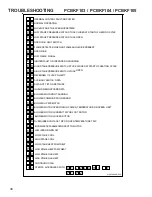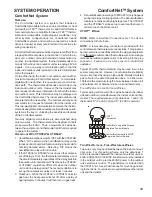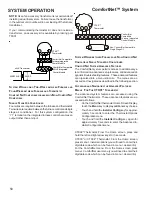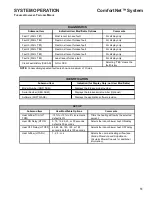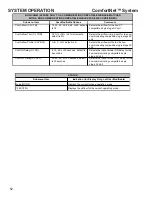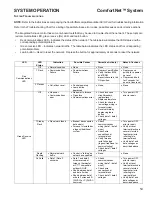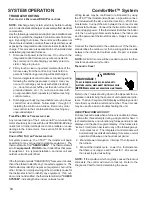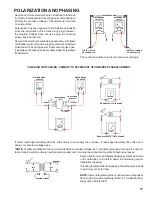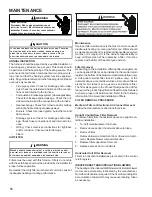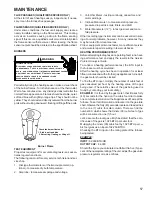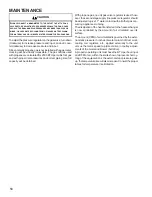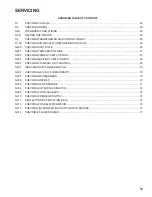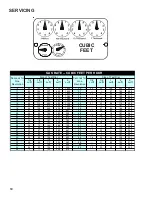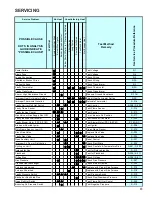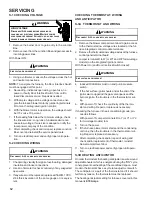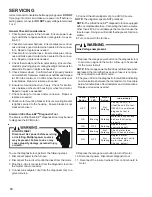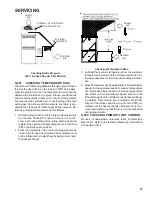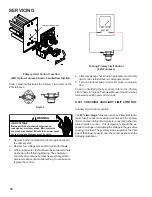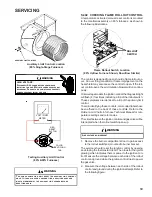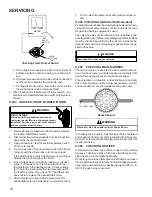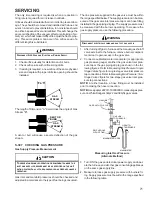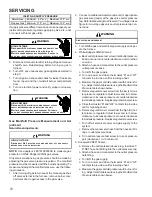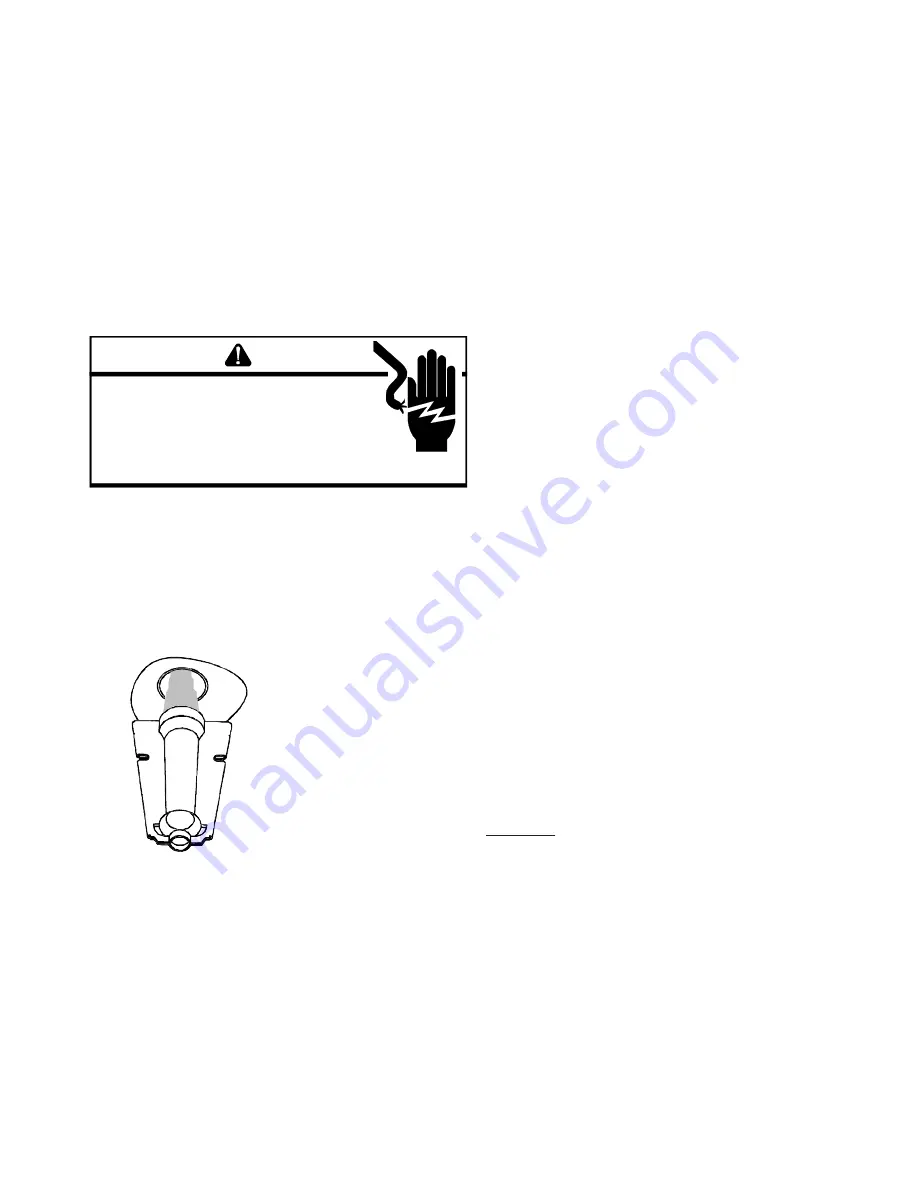
57
MAINTENANCE
FLUE PASSAGES (QUALIFIED SERVICER ONLY)
At the start of each heating season, inspect and, if neces-
sary, clean the furnace flue passages.
FLAME SENSOR (QUALIFIED SERVICER ONLY)
Under some conditions, the fuel or air supply can create a
nearly invisible coating on the flame sensor. This coating
acts as an insulator, causing a drop in the flame sensing
signal. If this occurs, a qualified servicer must carefully clean
the flame sensor with steel wool. After cleaning, the flame
sensor output should be as listed on the specification sheet.
BURNERS
WARNING
HIGH
VOLTAGE
E
LECTRICAL COMPONENTS ARE CONTAINED IN BOTH
COMPARTMENTS.
T
O AVOID ELECTRICAL SHOCK, INJURY OR
DEATH, DO NOT REMOVE ANY INTERNAL COMPARTMENT COVERS
OR ATTEMPT ANY ADJUSTMENT.
C
ONTACT A QUALIFIED
SERVICE AGENT AT ONCE IF AN ABNORMAL FLAME
APPEARANCE SHOULD DEVELOP.
Periodically during the heating season make a visual check
of the burner flames. Turn the furnace on at the thermostat.
Wait a few minutes since any dislodged dust will alter the
normal flame appearance. Flames should be stable, quiet,
soft and blue with slightly orange tips. They should not be
yellow. They should extend directly outward from the burner
ports without curling downward, floating or lifting off the ports.
Check the burner flames for:
1. Stable, soft and blue
2. Not curling, floating, or lifting off.
Burner Flame
TEST EQUIPMENT
Proper test equipment for accurate diagnosis is as essen-
tial as regular hand tools.
The following is a must for every service technician and ser-
vice shop.
1.
Dial type thermometers or thermocouple meter (op-
tional) - to measure dry bulb temperature.
2.
Amprobe - to measure amperage and voltage.
3.
Volt-Ohm Meter - testing continuity, capacitors, and
motor windings.
4.
Inclined Manometer - to measure static pressure,
pressure drop across coils, filters, and draft.
5.
Water Manometer (12") - to test gas inlet and mani-
fold pressure.
Other recording type instruments can be essential in solv-
ing abnormal problems, however, in many instances they
may be rented from local sources.
Proper equipment promotes faster, more efficient service
and accurate repairs resulting in fewer call backs.
HEATING PERFORMANCE TEST
Before attempting to diagnose an operating fault, run a heat-
ing performance test and apply the results to the
Service
Problem Analysis Guide.
To conduct a heating performance test, the BTU input to
the furnace must be calculated.
After the heating cycle has been in operation for at least
fifteen minutes and with all other gas appliances turned off,
the gas meter should be clocked.
To find the BTU input, multiply the number of cubic feet of
gas consumed per hour by the heating value of the gas
being used. (The calorific value of the gas being used is
found by contacting your local utility.)
EXAMPLE:
It is found by the gas meter, that it takes forty
(40) seconds for the hand on the cubic foot dial to make
one complete revolution, with all appliances off, except the
furnace. Take this information and locate it on the gas rate
chart. Observe the forty (40) seconds, locate and read across
to the one (1) cubic foot dial column. There we find the
number 90, which shows that ninety (90) cubic feet of gas
will be consumed in one (1) hour.
Let's assume the local gas utility has stated that the calo-
rific value of the gas is 1,025 BTU per cubic foot.
Multiplying the ninety (90) cubic feet by 1,025 BTU per cu-
bic foot gives us an input of 92,250 BTUH.
Checking the BTU input on the rating plate of the furnace
being tested.
EXAMPLE:
INPUT:
92,000 BTU/HR
OUTPUT CAP:
84,000
Should the figure you calculated not fall within five (5) per-
cent of the nameplate rating of the unit, adjust the gas valve
pressure regulator or resize orifices.

